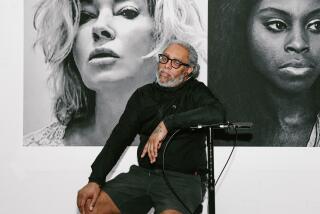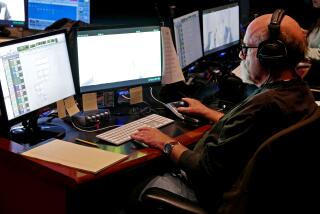Pacific Standard Time: Carl Stone
It may sound crazy to link Carl Stone, 58, a Los Angeles pioneer in computer music and champion of experimental music, with Britney Spears. But hear us out.
In 2007, Stone, who performs Saturday at the Getty Center as part of “Pacific Standard Time,” composed a musical piece called “Dino’s,” which samples “Oops! ... I Did It Again.”
When Stone is done with the song — a den of metallic rhythms and mysterious musical snippets — Spears appears, sounding like a replicant busker under the dystopian sky in “Blade Runner.”
The composition, by turns menacing and tender, transforms the familiar song into something disquietly unfamiliar, and offers a key to Stone’s groundbreaking aesthetic.
“I’m trying to hold up a sonic magnifying glass over music and reveal some truth about music or sound that may not have been apparent to someone listening before,” an amiable Stone explained last week. “I want to create a different kind of musical sensibility that makes people say, ‘Wow, what’s going on here?’”
Stone was selected for “Pacific Standard Time,” a six-month series of exhibitions focusing on Southern California art from 1945 to 1980, for his “impact not only on Los Angeles art but the larger world,” said Laurel Kishi, performing arts manager of the Getty Center. “Today we take computer music and sampling for granted. But Carl was one of the first people to do it.”
Stone found his calling in the 1970s, when he was a long-haired music nerd from Woodland Hills. He attended CalArts, where he was assigned a work-study job in the music library, recording three albums at a time on three tape recorders.
“What I began to hear are musical collisions,” he said. “What happens if you have African ceremonial music on top of a Schoenberg string trio on top of a 16th century madrigal? ‘Hey, that sounds pretty interesting.’ That set in motion some gears inside my brain of what happens when you take musical material and re-contextualize it.”
Following graduation, Stone became music director at L.A. radio station KPFK, and a passionate promoter of new music at such leading-edge venues as the Theater Vanguard and Café Figueroa.
In the late ‘70s his radio show, where he played minimalist composers such as La Monte Young and experimental local composers like David Rosenboom, formed the heart of L.A.’s musical avant-garde.
“Carl’s show was a must-hear for both fans and practitioners,” remembered composer Mark Trayle, co-chair of the composition department at CalArts.
While at the radio station, Stone hatched a musical experiment that became, he said, “the hallmark of my style.”
He dubbed a 1 ½-minute passage of harpsichord music from baroque composer Henry Purcell (the theme used by Benjamin Britten in “The Young Person’s Guide to Orchestra”) on two tape recorders. He then re-recorded the two passages together, slightly out of sync with one another. He repeated the process until he had offbeat layers of 1,024 harpsichords, a wall of sound that would have blown Purcell’s baroque mind.
Throughout the ‘80s and ‘90s, Stone perfected MIDI technology. He mixed and manipulated prerecorded music, like Mussorgsky’s “Pictures at an Exhibition” and random city sounds, into a congeries of kaleidoscopic works, which he performed at Los Angeles galleries and clubs.
“After years of electronic music being about the limitations of the equipment, all of a sudden, with Carl, it didn’t seem limited anymore,” said critic and composer Kyle Gann, author of “American Music in the Twentieth Century.” “Other composers were starting to use laptops then, but Carl’s music was by far the most beautiful I had heard.”
In Saturday’s concert, Stone will re-create the piece, titled “Sukothai,” layer by deepening layer on his laptop. Stone, a musical trickster who values intuition and random sounds, said he doesn’t want to impose meaning on his music with titles. So he has arbitrarily named most of his works after his favorite Asian restaurants.
For the last 10 years, Stone has divided his time between L.A. and Tokyo (he teaches sound design at Chukyo University), and woven the music of Asia into his brocades of sound. His harmony of Western and Eastern sensibilities will be on display Saturday, where he will perform a piece with Min Xiao-Fen on vocals and pipa, a traditional Chinese lute, and unveil a new work, based on a baroque work by Louis Couperin, featuring the acclaimed pianist
Gloria Cheng on harpsichord.
“I love things that reference the past and look into the future,” Stone said, referring to Saturday’s program. “We have the hook of familiarity with the surprise of the new, a magical conjuring mixed in with logical thought.”
And would he consider conjuring his Britney Spears piece as an encore? “Well,” said Stone wryly, “if the crowd demands it.”
More to Read
The biggest entertainment stories
Get our big stories about Hollywood, film, television, music, arts, culture and more right in your inbox as soon as they publish.
You may occasionally receive promotional content from the Los Angeles Times.






